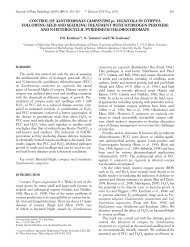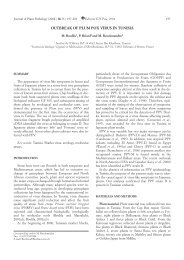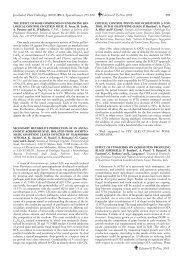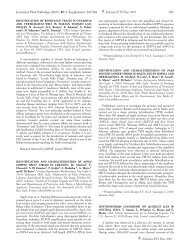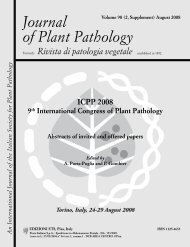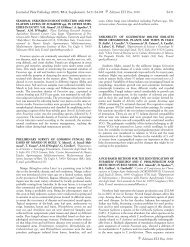Journal of Plant Pathology - Sipav.org
Journal of Plant Pathology - Sipav.org
Journal of Plant Pathology - Sipav.org
You also want an ePaper? Increase the reach of your titles
YUMPU automatically turns print PDFs into web optimized ePapers that Google loves.
<strong>Journal</strong> <strong>of</strong> <strong>Plant</strong> <strong>Pathology</strong> (2011), 93 (1, Supplement), S1.43-S1.51 S1.45<br />
gent for the grapevine pathosystem to move towards an integrated<br />
production <strong>of</strong> grapes giving priority to production systems<br />
that are economically viable with respect to the environment. Understanding<br />
the factors that trigger the development <strong>of</strong> an epidemic<br />
is essential if we are to create and implement effective<br />
strategies for disease management. Modelling is a key approach<br />
allowing to handle various scenarios for pathogen, host, and/or<br />
crop management. We have to differentiate empirical models<br />
from mechanistic ones. Empirical models tend to summarize the<br />
general relationships among the host, the pathogen and the environment<br />
and can be used to infer the underlying biology <strong>of</strong> a system<br />
without directly identifying causality (De Wolf and Isard,<br />
2007). For example, they look for the relationships between climatic<br />
variables and the appearance <strong>of</strong> disease symptoms. These<br />
kinds <strong>of</strong> models usually trigger one stage <strong>of</strong> the disease cycle (e.g..<br />
primary infection, dormancy, etc.). Most <strong>of</strong> the time, for the<br />
grapevine pathosystem, these models are weather-driven with no<br />
or little input variables linked to the disease (e.g. source <strong>of</strong> primary<br />
inoculums). They can be developed to predict the risk <strong>of</strong><br />
disease appearance for one region but need to be calibrated to be<br />
useful for another region. They <strong>of</strong>ten lack in predicting a level <strong>of</strong><br />
risk. Mechanistic models provide a convenient means to combine<br />
a number <strong>of</strong> sub-models representing unique parts <strong>of</strong> the disease<br />
cycle to discover causal relationships between the components <strong>of</strong><br />
the system. These models are used to explore the relationship in<br />
the pathosystem for a wide range <strong>of</strong> scenarios to find the most<br />
favourable or unfavourable conditions for disease development<br />
or to identify part <strong>of</strong> the disease cycle that needs further experiments.<br />
These types <strong>of</strong> models are however usually not appropriate<br />
for disease risk prediction. The grape-powdery mildew<br />
pathosystem is characterised by a polycyclic pathogen capable <strong>of</strong><br />
explosive multiplication, a host population with a high degree <strong>of</strong><br />
spatial structure at the field level and with a complex architecture<br />
at the individual plant level, exhibiting rapid changes over time.<br />
Different kinds <strong>of</strong> models have been developed, either empirical<br />
models, to predict the primary inoculum risk based on more or<br />
less complex rules and data (Kast, 1997; Gubler et al., 1999;<br />
Gadoury et al., 1990) or mechanistic models to describe the secondary<br />
infections or the epidemics’ development (Chellemi and<br />
Marois, 1992; Sall, 1980). A brief review <strong>of</strong> these models can be<br />
found in Legler et al. (2010). However, none <strong>of</strong> these models are<br />
yet able to predict the time and amount <strong>of</strong> primary inoculum and<br />
the protection against the disease is very <strong>of</strong>ten systematic. Because<br />
<strong>of</strong> the tight relationship between powdery mildew and its<br />
host (Doster and Schnathorst, 1985; Gadoury et al., 2003) and <strong>of</strong><br />
the spatial localization <strong>of</strong> primary inoculum on the vine stock, we<br />
hypothesized that the dynamic changes in crop structure and susceptibility<br />
should be considered as key factors for explaining<br />
variability in the severity <strong>of</strong> epidemic behaviour. Interactions between<br />
diseases and vine growth were investigated in several studies<br />
(Evans et al., 2006; Gadoury et al., 2001; Zahavi et al., 2001)<br />
and we could show that the high heterogeneity in disease progression<br />
makes the spatial disease prediction very difficult<br />
(Calonnec et al., 2009). Then, we devised a simulation model to<br />
better understand the vine/powdery mildew interactions and to<br />
explore how the host development and management can modify<br />
disease spread. The model is an epidemiological simulation coupling<br />
vine growth with the dispersal and disease dynamics <strong>of</strong><br />
Erysiphe necator at the vine stock scale (Calonnec et al., 2008). It<br />
is mechanistic, with sub-models either coming from the literature<br />
or from empirical data. The model allowed simulating the spatiotemporal<br />
dynamics <strong>of</strong> host growth and epidemic development<br />
beginning from a range <strong>of</strong> climatic conditions, production systems<br />
and initial conditions for the density and location <strong>of</strong> the<br />
pathogen. Particularly, the model takes into account shoot topping,<br />
which has for effect, to enhance the development <strong>of</strong> secondary<br />
shoots and the emergence <strong>of</strong> new susceptible leaves during<br />
the epidemic process. Input variables are environmental (temperature,<br />
wind speed and direction) or related to the pathogen<br />
(location and onset <strong>of</strong> primary infection). Input parameters characterise<br />
the crop system (number <strong>of</strong> buds, distance between<br />
buds, shoot topping, vigour), and conditions <strong>of</strong> growth for the<br />
vine and the pathogen. Output describes, at each time step, number,<br />
age and pattern <strong>of</strong> the healthy and infected <strong>org</strong>ans, infected<br />
and infectious leaf area and aerial density <strong>of</strong> spores released. A<br />
focus will be done on the bases <strong>of</strong> the model and the sensitivity <strong>of</strong><br />
the epidemic to variation <strong>of</strong> parameters <strong>of</strong> pathogen, plant<br />
growth or crop management as well as the relationship between<br />
host and disease variables at key periods in the epidemic process<br />
for different conditions <strong>of</strong> vine vigour.<br />
Calonnec A., Cartolaro P., Chadoeuf J., 2009. Highlighting features<br />
<strong>of</strong> spatio-temporal spread <strong>of</strong> powdery mildew epidemics in the<br />
vineyard using statistical modeling on field experimental data.<br />
Phytopathology 99: 411-422.<br />
Calonnec A., Cartolaro P., Naulin J.M., Bailey D., Langlais M., 2008.<br />
A host-pathogen simulation model: powdery mildew <strong>of</strong><br />
grapevine. <strong>Plant</strong> <strong>Pathology</strong> 57: 493-508.<br />
Chellemi D.O., Marois J.J., 1992. Development <strong>of</strong> a demographic<br />
model for Uncinula necator by using a microcomputer spreadsheet<br />
program. Phytopathology 81: 250-254.<br />
De Wolf E., Isard S., 2007. Disease cycle approach to plant disease<br />
prediction. Annual Review <strong>of</strong> Phytopathology 45: 203-220.<br />
Doster M.A., Schnathorst W.C., 1985. Effects <strong>of</strong> leaf maturity and<br />
cultivar resistance on development <strong>of</strong> the powdery mildew fungus<br />
on grapevines. Phytopathology 75: 318-321.<br />
Evans K., Crisp P., Scott E.S., 2006. Applying spatial information in a<br />
whole-<strong>of</strong>-block experiment to evaluate spray programs for powdery<br />
mildew in <strong>org</strong>anic viticulture. Proceedings 5th International<br />
Workshop on Grapevine Downy and Powdery Mildew, San Michele<br />
all’Adige 2006: 169-171.<br />
Gadoury D., Pearson R.C., 1990. Ascocarp dehiscence and ascospore<br />
discharge by Uncinula necator. Phytopathology 80: 393-401.<br />
Gadoury D., Seem R., Ficke A., Wilcox W., 2003. Ontogenic resistance<br />
to powdery mildew in grape berries. Phytopathology 93: 547-<br />
555.<br />
Gadoury D.M., Seem R.C., Pearson R.C., Wilcox W.F., Dunst R.M.,<br />
2001. Effects <strong>of</strong> powdery mildew on vine growth, yield, and quality<br />
<strong>of</strong> Concord grapes. <strong>Plant</strong> Disease 85: 137-140.<br />
Gubler W.D., Rademacher M.R., Vasquez S.J., 1999. Control <strong>of</strong> Powdery<br />
Mildew Using the UC Davis Powdery Mildew Risk Index.<br />
APSnet Features. Online. doi: 10.1094/APSnetFeature-1999-<br />
0199.<br />
Kast K., 1997. A step by step risk analysis (SRA) used for planning<br />
sprays against powdery mildew (OiDiag-System). Viticulture Enological<br />
Science 52: 230-321.<br />
Legler S.E., Caffi T., Rossi V., Giosuè S., 2010. Modelling the life cycle<br />
<strong>of</strong> Erysiphe necator. Proceedings 6 th International Workshop on<br />
Grapevine Downy and Powdery Mildew, Bordeaux 2010: 99-102.<br />
Sall M.A., 1980. Epidemiology <strong>of</strong> grape powdery mildew: a model.<br />
Phytopathology 70: 338-342.<br />
Zahavi T., Reuveni M., Scheglov D., Lavee S., 2001. Effect <strong>of</strong><br />
grapevine yraining systems on development <strong>of</strong> powdery mildew.<br />
European <strong>Journal</strong> <strong>of</strong> <strong>Plant</strong> <strong>Pathology</strong> 107: 495-501.<br />
ELABORATION AND VALIDATION OF A DOWNY<br />
MILDEW FORECAST MODEL REGARDING SOIL-<br />
BORNE INFECTIONS. B. Berkelmann-Loehnertz 1 , O. Baus 1 ,<br />
H. Hassemer-Schwarz 2 and C. Fruehauf 3 . 1 Geisenheim Research<br />
Center, Section <strong>of</strong> Phytomedicine, Von-Lade-Strasse 1, 65366<br />
Geisenheim, Germany. 2 Deutscher Wetterdienst (German Meteorological<br />
Service), Kreuzweg 25, 65366 Geisenheim, Germany.<br />
3 Deutscher Wetterdienst (German Meteorological Service), Centre



